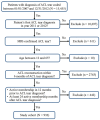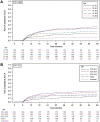Nonoperative Treatment of Anterior Cruciate Ligament Tears With 5-Year Follow-up
- PMID: 40052181
- PMCID: PMC11881924
- DOI: 10.1177/23259671251314441
Nonoperative Treatment of Anterior Cruciate Ligament Tears With 5-Year Follow-up
Abstract
Background: It remains unknown whether anterior cruciate ligament (ACL) reconstruction (ACLR) alters the natural history of degenerative changes or prevents further injury compared with nonoperative treatment.
Purpose/hypothesis: The purpose of this study was to evaluate the midterm risk of knee surgery in patients who sustained an ACL tear treated with initial nonoperative management. It was hypothesized that the majority of patients who pursue initial nonoperative treatment after ACL rupture will not undergo further surgery within 5 years.
Study design: Case series; Level of evidence, 4.
Methods: An electronic health record search was performed for all patients aged 12 to 65 years from 2011 to 2012 with magnetic resonance imaging-confirmed ACL tear. Patients who did not undergo ACLR within 6 months after diagnosis comprised our initial cohort. Patients were longitudinally followed until August 31, 2017. The primary outcome was an occurrence of ipsilateral knee surgery, including ACLR and non-ACLR procedures.
Results: A total of 932 patients with a mean age of 36.2 ± 13.6 years were included. The mean follow-up time was 57.9 ± 7.4 months. During the follow-up period, 365 patients (39.2%) had ipsilateral knee surgery, with a mean time from ACL tear diagnosis to the first procedure of 11.9 ± 13.0 months. Overall, 67% of surgeries occurred within 12 months of diagnosis. ACLR was performed in 211 patients (22.6%); 284 patients had non-ACLR knee procedures, with 130 undergoing ACLR and non-ACLR surgery and 154 patients undergoing non-ACLR procedures alone. After adjusting for demographic and clinical factors, younger age remained a significant risk factor for undergoing ACLR: patients aged 12 to 18 years and those aged 19 to 30 years had similar adjusted hazard ratios compared with patients aged 51 to 65 years (5.49 [95% CI, 2.78-10.88] and 5.48 [95% CI, 2.85-10.53], respectively; P < .001 for both).
Conclusion: In this universally insured, contained patient cohort, 39.2% of the patients underwent a subsequent surgical procedure on the ipsilateral knee within 5 years of ACL injury, with 22.6% of patients opting to undergo delayed ACLR. Younger age was an independent risk factor for undergoing ACLR.
Keywords: ACL; aging athlete; knee; meniscus; physical therapy/rehabilitation.
© The Author(s) 2025.
Conflict of interest statement
One or more of the authors has declared the following potential conflict of interest or source of funding: This study was supported by a grant from the Kaiser Permanente Community Benefit Program (grant No. RNG209454). C.M.R. has received grant support from Arthrex and education payments from Arthrex and Smith & Nephew. AOSSM checks author disclosures against the Open Payments Database (OPD). AOSSM has not conducted an independent investigation on the OPD and disclaims any liability or responsibility relating thereto. Ethical approval for this study was obtained from Kaiser Permanente Northern California (reference No. 00001045).
Figures




Similar articles
-
Comparison of Anterior Cruciate Ligament Tears Treated Nonoperatively Versus With Reconstruction: Risk of Subsequent Surgery.Am J Sports Med. 2022 Mar;50(3):652-661. doi: 10.1177/03635465211066940. Epub 2022 Jan 7. Am J Sports Med. 2022. PMID: 34994581
-
Is Anterior Cruciate Ligament Reconstruction Effective in Preventing Secondary Meniscal Tears and Osteoarthritis?Am J Sports Med. 2016 Jul;44(7):1699-707. doi: 10.1177/0363546516634325. Epub 2016 Mar 8. Am J Sports Med. 2016. PMID: 26957217
-
Anterior Cruciate Ligament Reconstruction in High School and College-Aged Athletes: Does Autograft Choice Influence Anterior Cruciate Ligament Revision Rates?Am J Sports Med. 2020 Feb;48(2):298-309. doi: 10.1177/0363546519892991. Epub 2020 Jan 9. Am J Sports Med. 2020. PMID: 31917613 Free PMC article.
-
Early Operative Versus Delayed or Nonoperative Treatment of Anterior Cruciate Ligament Injuries in Pediatric Patients.J Athl Train. 2016 May;51(5):425-7. doi: 10.4085/1062-6050.51.5.11. Epub 2016 May 31. J Athl Train. 2016. PMID: 27244126 Free PMC article. Review.
-
Does Anterior Cruciate Ligament Reconstruction Protect the Meniscus and Its Repair? A Systematic Review.Orthop J Sports Med. 2020 Jul 28;8(7):2325967120933895. doi: 10.1177/2325967120933895. eCollection 2020 Jul. Orthop J Sports Med. 2020. PMID: 32782901 Free PMC article. Review.
Cited by
-
No differences in patient-reported outcomes (PROMs) and complications after anterior cruciate ligament (ACL) reconstruction with bone-patellar tendon-bone (BPTB) or hamstrings (HT) in patients aged 50 or older.J Exp Orthop. 2025 Jul 18;12(3):e70371. doi: 10.1002/jeo2.70371. eCollection 2025 Jul. J Exp Orthop. 2025. PMID: 40689096 Free PMC article.
References
-
- Anderson AF, Anderson CN. Correlation of meniscal and articular cartilage injuries in children and adolescents with timing of anterior cruciate ligament reconstruction. Am J Sports Med. 2015;43(2):275-281. - PubMed
-
- Ardern CL, Webster KE, Taylor NF, Feller JA. Return to sport following anterior cruciate ligament reconstruction surgery: a systematic review and meta-analysis of the state of play. Br J Sports Med. 2011;45(7):596-606. - PubMed
-
- Brambilla L, Pulici L, Carimati G, et al.. Prevalence of associated lesions in anterior cruciate ligament reconstruction: correlation with surgical timing and with patient age, sex, and body mass index. Am J Sports Med. 2015;43(12):2966-2973. - PubMed
-
- Chalmers PN, Mall NA, Moric M, et al.. Does ACL reconstruction alter natural history? A systematic literature review of long-term outcomes. J Bone Joint Surg Am. 2014;96(4):292-300. - PubMed
-
- Damsted C, Skou ST, Hölmich P, et al.. Early surgery versus exercise therapy and patient education for traumatic and nontraumatic meniscal tears in young adults—an exploratory analysis from the DREAM trial. J Orthop Sports Phys Ther. 2024;54(5):340-349. - PubMed
LinkOut - more resources
Full Text Sources

